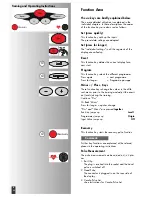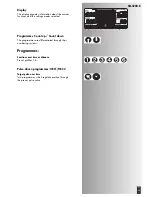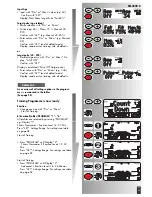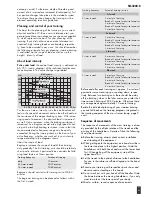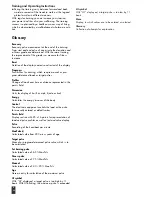
coronary vessels). Furthermore, depth of breathing and
amount of air inspired are increased (vital capacity). Furt-
her positive changes take place in the metabolic system.
To achieve these positive changes the training must be
planned according to certain guidelines.
Planning and control of your training
The basis for the planning of the training is your current
physical condition. With an exercise tolerance test your
general practitioner can diagnose your personal capabili-
ty, which represents the basis for your planning of the
training. If you did not have an exercise tolerance test
executed, high training loads or overloading, respective-
ly, have to be avoided in any case. You should remember
the following principle for your planning: stamina training
is controlled via the scope of load as well as via the
height / intensity of load.
About load intensity
Pulse under load:
the optimal load intensity is achieved at
65–75 % (comp. diagram) of the individual cardiovascu-
lar performance. This value changes age-related.
For the cross trainer, intensity is on the one hand control-
led via the speed of movement and on the other hand via
the resistance of the magnet braking system. With increa-
sing speed of movement, the physical load is increased
as well. It also increases, when the braking resistance is
increased. As a beginner avoid a too high speed or trai-
ning with a too high braking resistance, since in that the
recommended pulse frequency range can be quickly
exceeded. During the training check on the basis of your
pulse frequency, whether you work out in your intensity
range according to the diagrams shown.
About the scope of load
Beginners increase the scope of load of their training
only gradually. The first training units should be relatively
short and in intervals. Sports medicine considers the follo-
wing load factors as fitness-positive:
Beginners should not start with training units of 30-60
minutes.
The beginner training can be planned as follows within
the first 4 weeks:
Training frequency
Duration of training
daily
10 minutes
2-3 times a week
20-30 minutes
1-2 times a week
30-60 minutes
Pulsediagramm
Fitness and Fat Burner
220
200
180
160
140
120
100
80
Pulse
Age
20 25 30 35 40 45 50 55 60 65 70 75 80
Maximalpulse
(220 minus Age)
Fitnesspulse
(75% of Max.Pulse)
Fat combustion pulse
(65% of Max.Pulse)
90
Before and after each training unit, approx. 5 minutes of
gymnastics serve warming up or cooling down, respec-
tively. Between two training units there should be a day
off (no training), when in the later course you prefer the 3
times a week training of 20-30 minutes. Otherwise there
are no arguments against a daily 10 minute training.
Beside the individual planning of your stamina training
you can fall back on the training programs integrated in
the training computer of the cross trainer (comp. page 9
cont).
Sequence of movements
The sequence of movements of the cross training is alrea-
dy provided by the elliptic rotation of the treads and the
position of the handle-bars. Despite of that, the following
should be observed:
■
Before the training, always check correct installation
and standing of the equipment.
■
When getting onto the equipment, one tread must be in
the lowest and one in the highest position. Grab the
handle-bars with both hands and mount the lower treat
first. When getting off the equipment, step off the
upper tread first.
■
Set the treads to the optimal distance to the handle-bars
for you; in that observe sufficient legroom to the hand-
le-bars.
■
Execute your training with respective sports shoes and
observe secure standing on the treads.
■
Do not work out with your hands off the handles. Grab
the frame between the moving handle-bars, if you only
want to work out the lower part of your body.
■
Mind a uniform, round sequence of movements.
Training frequency
Extent of training session
3 times a week
2 minutes of training
Break of 1 minute for physical exercises
2 minutes of training
Break of 1 minute for physical exercises
2 minutes of training
3 times a week
3 minutes of training
Break of 1 minute for physical exercises
3 minutes of training
Break of 1 minute for physical exercises
2 minutes of training
3 times a week
4 minutes of training
Break of 1 minute for physical exercises
4 minutes of training
Break of 1 minute for physical exercises
3 minutes of training
3 times a week
5 minutes of training
Break of 1 minute for physical exercises
4 minutes of training
Break of 1 minute for physical exercises
4 minutes of training
4th week
3rd week
2nd week
1st week
SM3200-8
31
GB




